Warf-3 Tablet 30's
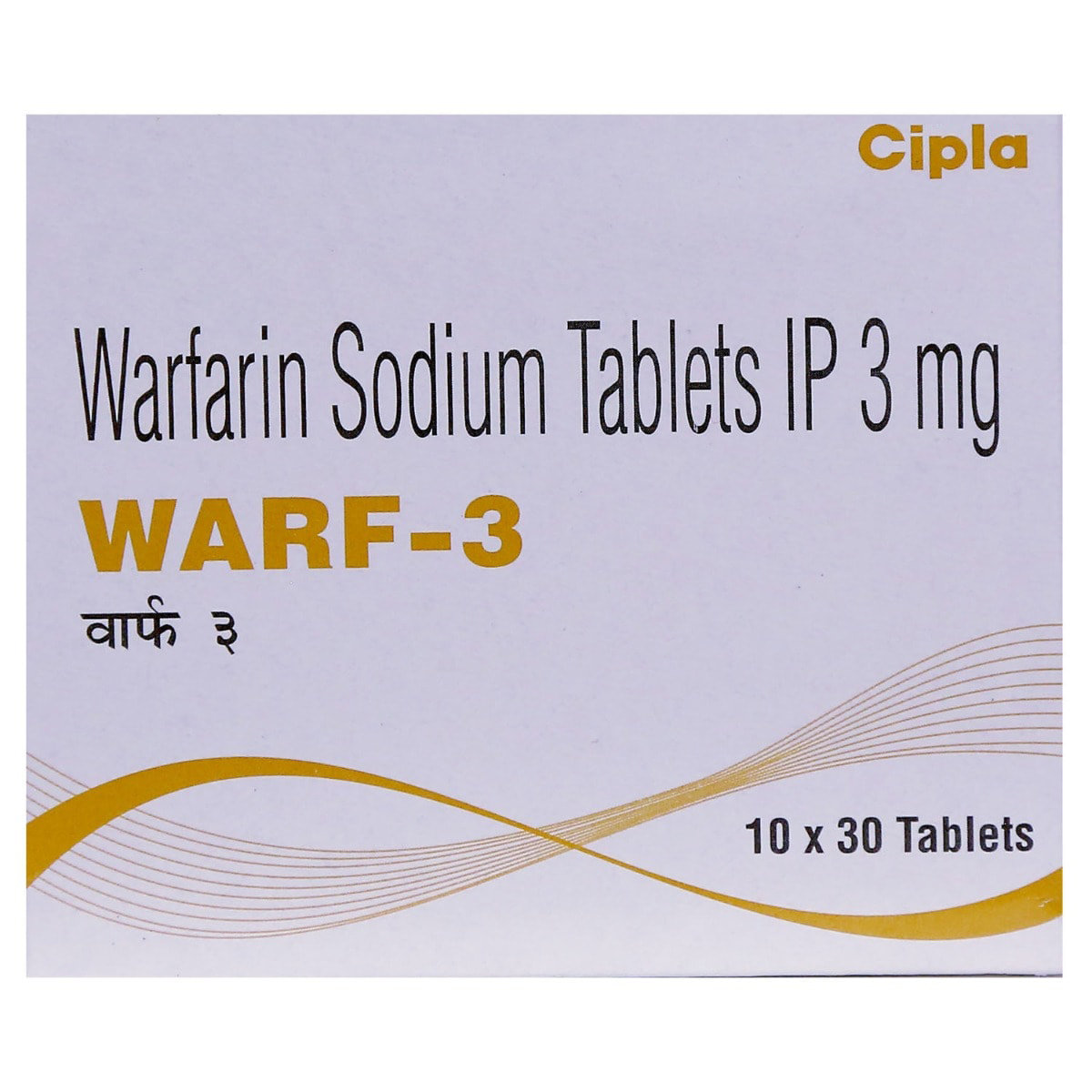
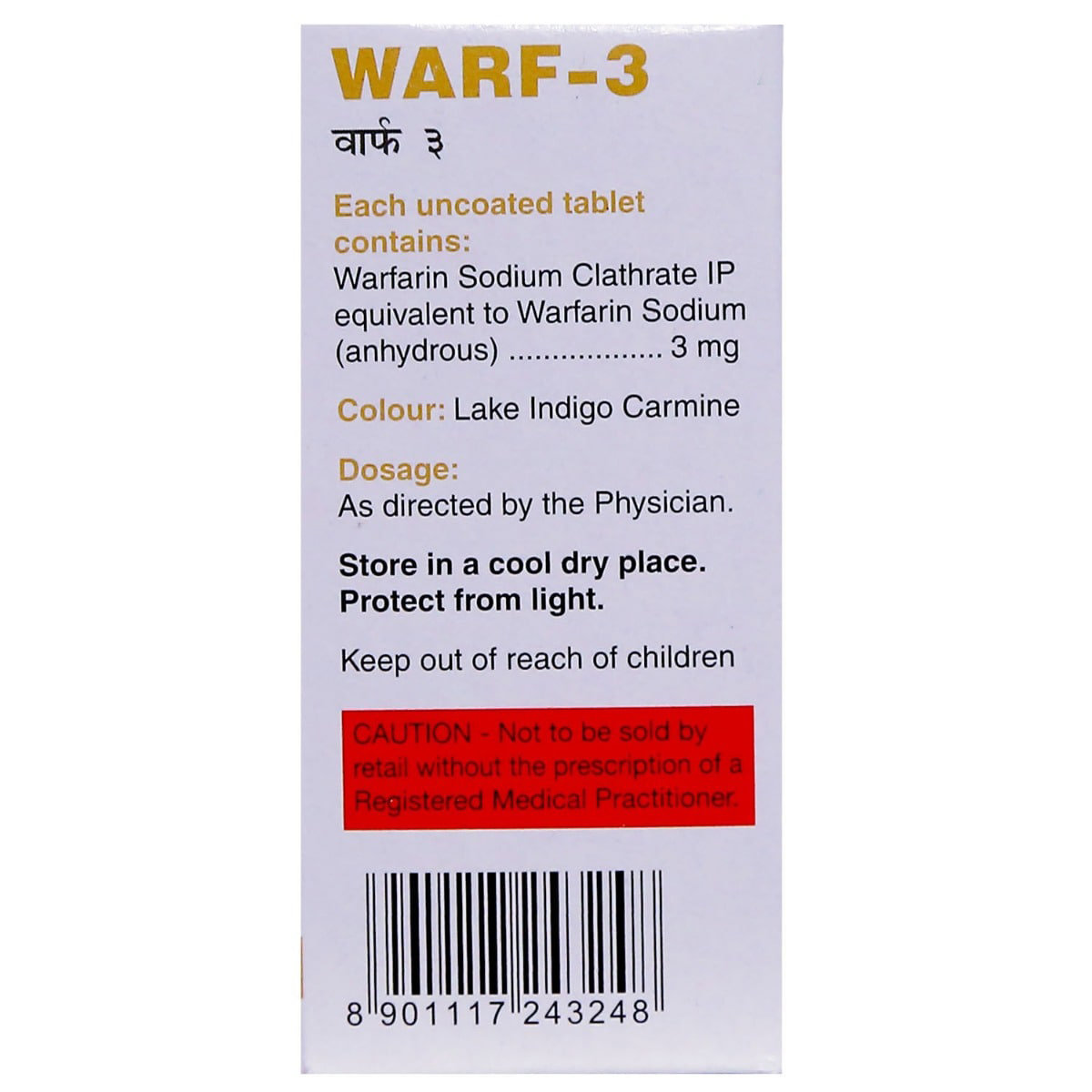
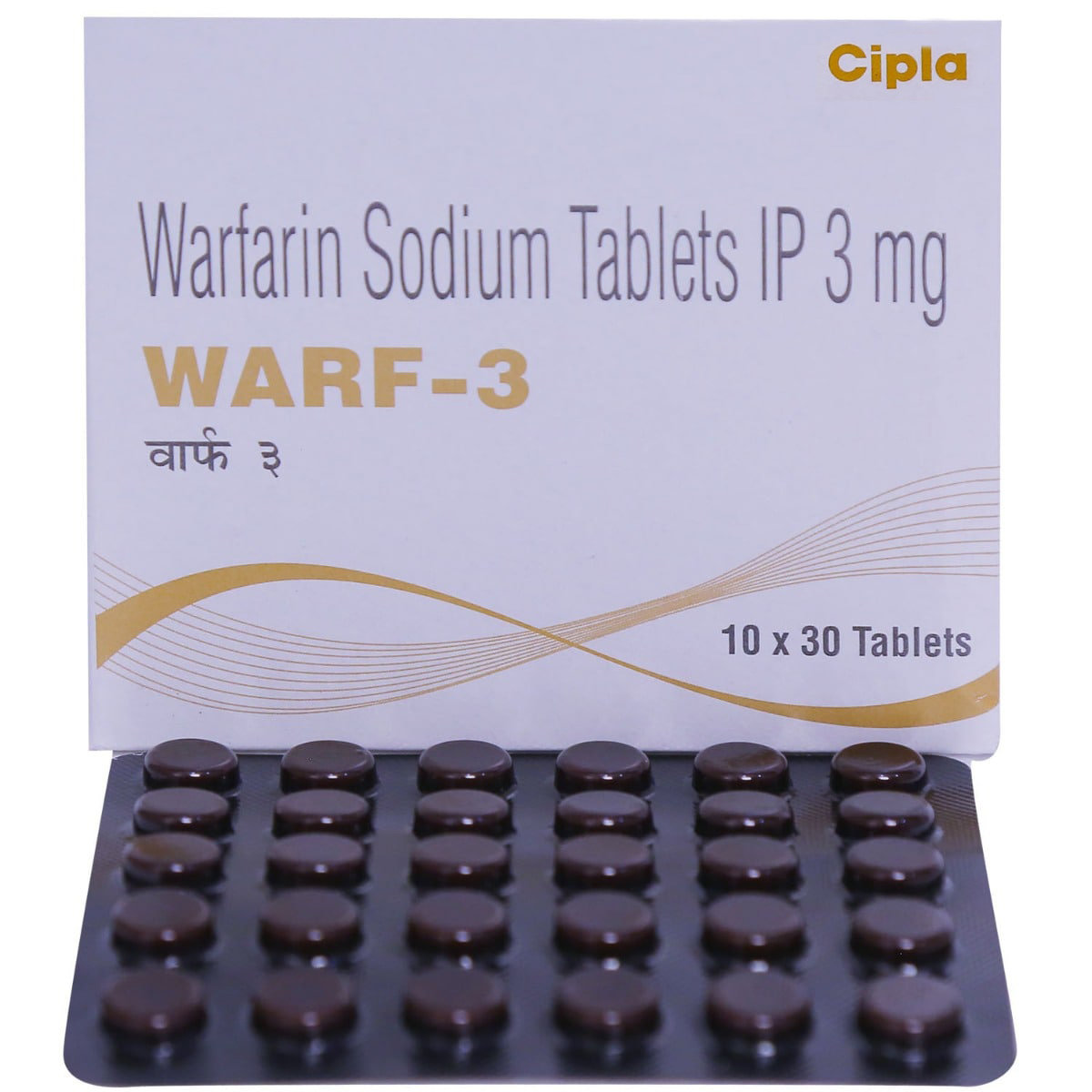
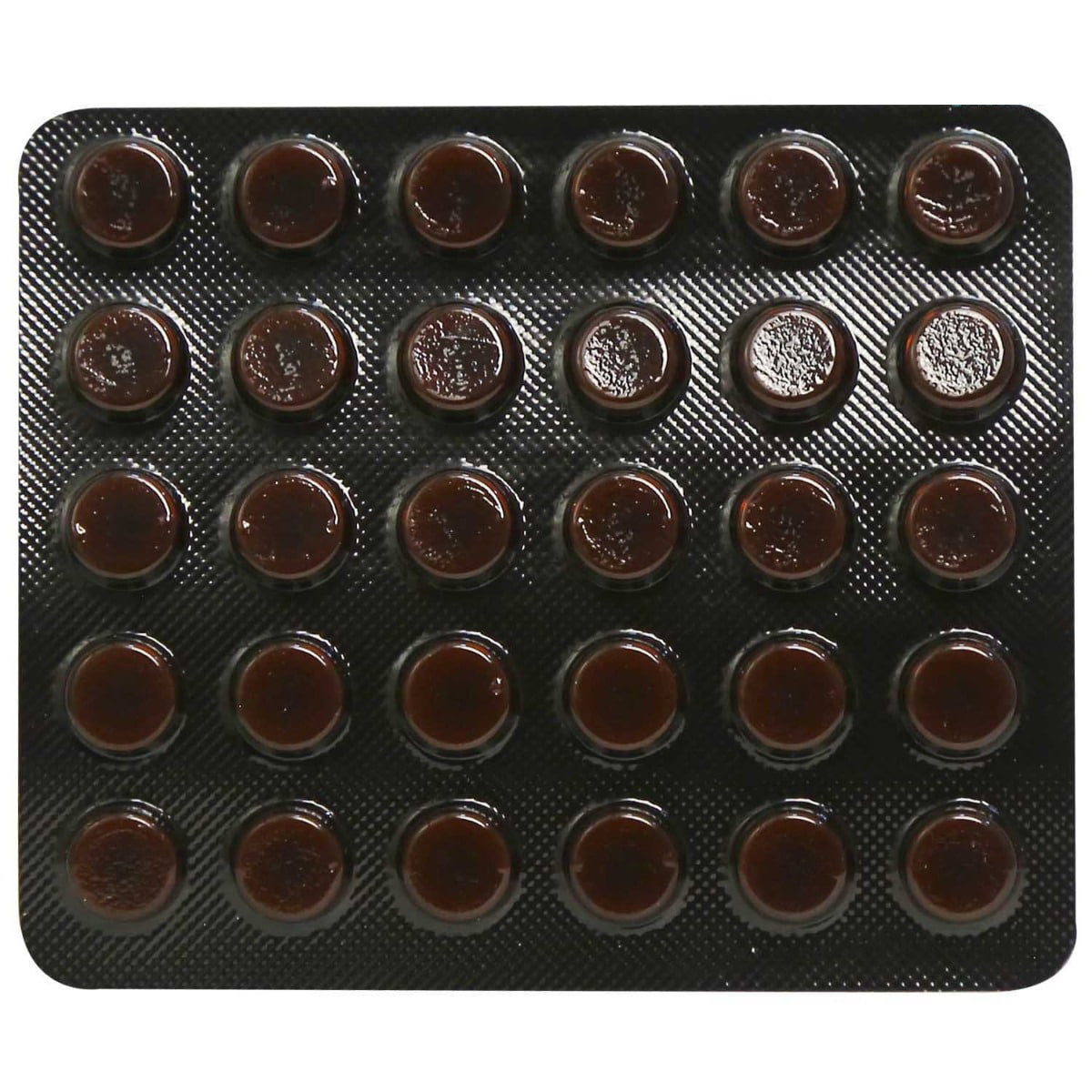
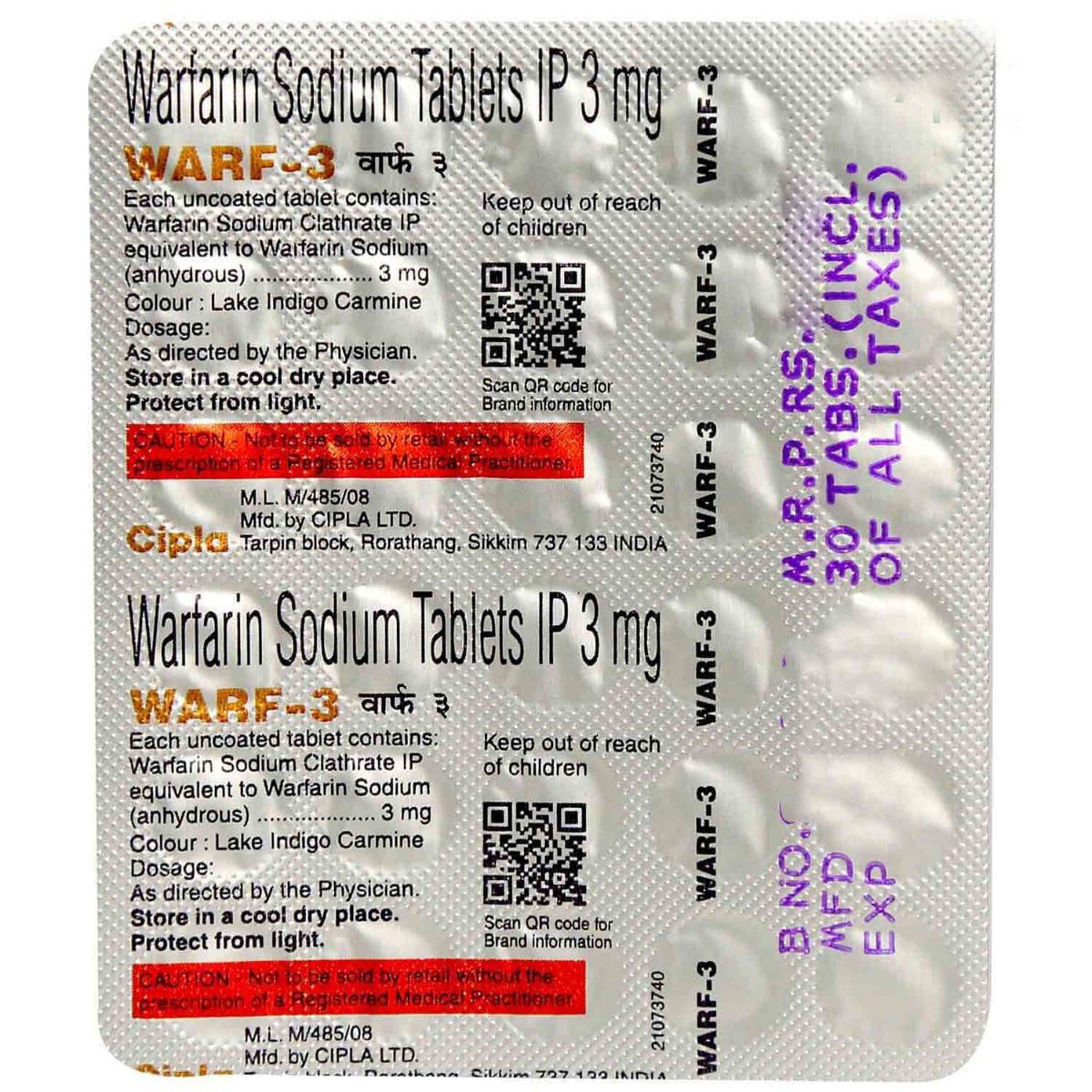





MRP ₹100
(Inclusive of all Taxes)
₹15.0 Cashback (15%)
Selected Pack Size:30
30 ₹90
(₹3.0 per unit)
In Stock
10 ₹34.7
(₹3.47 per unit)
In Stock
Provide Delivery Location
Online payment accepted
 Prescription drug
Prescription drugWhats That
Composition :
Manufacturer/Marketer :
Consume Type :
Expires on or after :
Return Policy :
About Warf-3 Tablet
Warf-3 Tablet belongs to a class of drugs known as anticoagulants (blood thinners). Warf-3 Tablet is primarily used to prevent and treat deep vein thrombosis (blood clots in leg veins) and pulmonary embolism (blood clots in the lung) by reducing the formation of a blood clot. Deep vein thrombosis is a medical condition in which blood clots form in deep veins usually in the legs. Pulmonary embolism is a condition in which blood clot blocks the arteries in the lungs.
Warf-3 Tablet contains Warfarin which works by inhibiting the production of clotting factors by decreasing the action of vitamin K. This prevents the conversion of fibrinogen (soluble protein) to fibrin (insoluble protein) thereby preventing blood clot formation.
Take Warf-3 Tablet with or without food as advised by the doctor and swallow it as a whole with a glass of water. Do not crush, chew or break it. Your doctor will advise you on how often you take your tablets based on your medical condition. Some people may experience unusual bleeding or skin rash. Most of these side effects of Warf-3 Tablet do not require medical attention and gradually resolve over time. However, if the side effects persist or worsen, please consult your doctor.
If you are known to be allergic to Warf-3 Tablet or any other medicines, please tell your doctor. If you are pregnant or breastfeeding, it is advised to consult a doctor before using Warf-3 Tablet . If you have a stomach ulcer, kidney or liver problems, high blood pressure, or bleeding problems, inform your doctor before taking Warf-3 Tablet . It would help if you had frequent INR (International Normalized Ratio) or prothrombin time tests to measure your blood-clotting time, as Warf-3 Tablet prolongs bleeding time. You must be cautious while shaving and brushing your teeth to avoid too much bleeding from the injury site.
Uses of Warf-3 Tablet
Directions for Use
Key Benefits
Warf-3 Tablet belongs to a class of drugs known as anticoagulants or blood thinner. Warf-3 Tablet is primarily used to prevent and treat deep vein thrombosis (blood clots in leg veins) and pulmonary embolism (blood clots in the lung) by reducing the formation of a blood clot. Warf-3 Tablet works by inhibiting the production of clotting factors by decreasing the action of vitamin K. This prevents the conversion of fibrinogen (soluble protein) to fibrin (insoluble protein) thereby preventing blood clots formation.
Storage
Drug Warnings
Warf-3 Tablet should be used with caution in children. Prolonged use of Warf-3 Tablet may cause hair loss. Regular blood tests are recommended while taking Warf-3 Tablet to check the time taken for your blood to clot and the level of platelets (blood cells). If you have a painful skin rash, inform your doctor immediately as it may be due to a serious condition called calciphylaxis (accumulation of calcium in small blood vessels of skin and fat tissues) which may cause painful skin ulcers, blood clots, and serious skin infections. Patients with chronic kidney disease are at high risk of getting calciphylaxis. If you have any high blood pressure, kidney, liver, or heart problems, please inform your doctor before taking Warf-3 Tablet so that the dose may be adjusted accordingly. Warf-3 Tablet may cause serious side effects and death of skin tissue (skin necrosis or gangrene). Call your doctor if you have pain, color, or temperature change in any area of your body or purple toes syndrome. Before undergoing any type of surgery tell your doctor that you are taking Warf-3 Tablet . Your doctor might tell you to stop taking Warf-3 Tablet . Warf-3 Tablet is pregnancy category D medicine and can cause birth defects, or miscarriage. So, if you are pregnant or planning for pregnancy or are a nursing mother tell your doctor that you are taking Warf-3 Tablet . Warf-3 Tablet should be used with caution in patients with severe Anemia (low RBC count), malignancies (any cancer), and Trauma (injuries).
Drug-Drug Interactions
Drug-Drug Interactions
Login/Sign Up
Taking tamoxifen with Warf-3 Tablet can increase the risk of bleeding.
How to manage the interaction:
Taking Tamoxifen with Warf-3 Tablet is not recommended but can be taken together if prescribed by a doctor. However, consult a doctor if you experience bleeding, vomiting, blood in your urine or stools, headache, dizziness, or weakness. Do not discontinue any medications without consulting a doctor.
Using Warf-3 Tablet together with stanozolol can increase the risk or severity of unusual bleeding.
How to manage the interaction:
Although taking Stanozolol and Warf-3 Tablet together can result in an interaction, it can be taken if a doctor has prescribed it. However, if you experience unusual bleeding or bruising, vomiting, blood in your urine or stools, headache, dizziness, or weakness, consult a doctor. Do not stop using any medications without a doctor's advice.
Co-administration of Warf-3 Tablet with Fluconazole can increase the risk of bleeding.
How to manage the interaction:
Although taking Fluconazole and Warf-3 Tablet together can result in an interaction, they can be taken together if prescribed by a doctor. However, if you experience unusual bleeding or bruising, vomiting, blood in your urine or stools, headache, dizziness, or weakness, consult a doctor immediately. Do not stop using any medications without consulting a doctor.
Coadministration of Warf-3 Tablet with Oxaprozin can increase the risk of bleeding.
How to manage the interaction:
Although taking Oxaprozin with Warf-3 Tablet together can result in an interaction, they can be taken together if prescribed by a doctor. However, if you experience unusual bleeding or bruising, vomiting, blood in your urine or stools, headache, dizziness, or weakness consult a doctor immediately. Do not stop using any medications without consulting a doctor.
The combined use of Warf-3 Tablet and Rivaroxaban can increase the risk of bleeding.
How to manage the interaction:
Co-administration of Warf-3 Tablet and Rivaroxaban can lead to an interaction, it can be taken if advised by a doctor. However, if you experience any symptoms like unusual bleeding or bruising, dizziness, lightheadedness, red or black, tarry stools, coughing up or vomiting fresh or dried blood that looks like coffee grounds, severe headache, and weakness, consult a doctor immediately. Do not stop using any medications without a doctor's advice.
Coadministration of Warf-3 Tablet with Gatifloxacin can increase the risk of bleeding.
How to manage the interaction:
Although taking Gatifloxacin and Warf-3 Tablet together can result in an interaction, they can be taken together if prescribed by a doctor. However, if you experience any signs and symptoms of unusual bleeding, like blood in urine, bruising, coughing up or vomiting blood that looks like coffee grounds, or having a severe headache, consult a doctor immediately. Do not stop using any medications without consulting a doctor.
Taking Warf-3 Tablet and thiopental can reduce the blood levels of Warf-3 Tablet, which may make the medication less effective.
How to manage the interaction:
Although taking Thiopental together with Warf-3 Tablet can result in an interaction, they can be taken together if prescribed by a doctor. However, if you experience chest pain, shortness of breath, sudden loss of vision, pain, redness, or swelling in an extremity, consult a doctor immediately. Do not discontinue any medicine without consulting a doctor.
Co-administration of Warf-3 Tablet with Capecitabine can increase the effect of Warf-3 Tablet.
How to manage the interaction:
Although there is a possible interaction between Capecitabine and Warf-3 Tablet, you can take these medicines together if prescribed by a doctor. However, if you notice unusual bleeding or bruising, vomiting, blood in your urine or stools, headache, dizziness, or weakness, contact a doctor immediately. Do not stop using any medications without consulting a doctor.
Coadministration of Warf-3 Tablet with Piroxicam can increase the risk of bleeding.
How to manage the interaction:
Although taking Piroxicam with Warf-3 Tablet together can result in an interaction, they can be taken together if prescribed by a doctor. However, if you experience unusual bleeding or bruising, vomiting, blood in your urine or stools, headache, dizziness, or weakness consult a doctor immediately. Do not stop using any medications without consulting a doctor.
Coadministration of metronidazole with Warf-3 Tablet can increase the risk of bleeding.
How to manage the interaction:
There is a possible interaction between metronidazole and Warf-3 Tablet, but they can be taken together if a doctor has prescribed them. Consult a doctor if experience unusual bleeding or bruising, vomiting, blood in your urine or stools, headache, dizziness, or weakness. Do not stop using any medications without talking to a doctor.
Drug-Food Interactions
Drug-Food Interactions
Login/Sign Up
Avocado, Black Liquorice, Broccoli, Brussels Sprouts, Cabbage, Collard Greens, Coriander, Turnip Greens, Spinach, Green Tea, Kale
How to manage the interaction:
Increasing vitamin K levels in the body can promote clotting and reduce the effectiveness of Warf-3 Tablet. Avoid or limit consumption of foods rich in vitamin K while being treated with Warf-3 Tablet.
Diet & Lifestyle Advise
- Avoid making any changes in your diet without first talking to your doctor.
- Opt for foods that are high in vitamin K (liver, leafy green vegetables, or vegetable oils) as Warf-3 Tablet may lower Vitamin K in your body.
- Cranberry juice, grapefruit juice, noni juice, and pomegranate juice may interact with Warf-3 Tablet and lead to unwanted side effects. Hence try to avoid these juices while taking Warf-3 Tablet .
- Avoid drinking alcohol as it increases risk of gastrointestinal ulcer/bleeding.
Side Effects of Warf-3 Tablet
- Unusual bleeding
- Skin rash
Habit Forming
Therapeutic Class
All Substitutes & Brand Comparisons
RX
Warf 3 Tablet 10's
Cipla Ltd
₹38.5
(₹3.47 per unit)
15% COSTLIER
Product Substitutes
Author Details
We provide you with authentic, trustworthy and relevant information
Drug-Diseases Interactions
Drug-Diseases Interactions
Login/Sign Up
FAQs
Drug-Drug Interactions Checker List
- ASPIRIN
- IBUPROFEN
- PHENYLBUTAZONE
- FEPRAZONE
- OXYPHENBUTAZONE
- GLUCAGON
- TOLBUTAMIDE
- PHENFORMIN
- QUINIDINE
- AMIODARONE
- PROPAFENONE
- NORTRIPTYLINE
- AMITRIPTYLINE
- FLUCONAZOLE
- MICONAZOLE
- KETOCONAZOLE
- CIPROFLOXACIN
- ERYTHROMYCIN
- LATAMOXEF
- GRISEOFULVIN
- METRONIDAZOLE
- NORFLOXACIN
- RIFAMPICIN
- AZTREONAM
- NEOMYCIN
- CEPHAMANDOLE
- CHLORAMPHENICOL
- NALIDIXIC ACID
- ALLOPURINOL
- GLUTETHIMIDE
Special Advise
- You should have regular platelet count, factor V assay, fibrinogen level test, prothrombin time test (PT or PT-INR) and the INR (international normalised ratio) to analyze your blood clotting time.
Disease/Condition Glossary
Deep vein thrombosis (blood clots in legs) is a medical condition in which blood clots form in deep veins usually in the legs. The symptoms include leg pain or swelling. Pulmonary embolism (blood clots in the lung) is a chronic condition that occurs as the blood clots break and travel to the lungs from deep veins in the legs or other parts of the body. The symptoms of pulmonary embolism include cough, chest pain, and shortness of breath.

Have a query?
Buy best Cardiology products by
Torrent Pharmaceuticals Ltd
Sun Pharmaceutical Industries Ltd
Lupin Ltd
Intas Pharmaceuticals Ltd
Cipla Ltd
Micro Labs Ltd
Macleods Pharmaceuticals Ltd
Abbott India Ltd
Ajanta Pharma Ltd
Ipca Laboratories Ltd
Eris Life Sciences Ltd
Mankind Pharma Pvt Ltd
Lloyd Healthcare Pvt Ltd
Dr Reddy's Laboratories Ltd
Glenmark Pharmaceuticals Ltd
Emcure Pharmaceuticals Ltd
Alembic Pharmaceuticals Ltd
Alkem Laboratories Ltd
East West Pharma India Pvt Ltd
USV Pvt Ltd
Zydus Healthcare Ltd
Aristo Pharmaceuticals Pvt Ltd
Elbrit Life Sciences Pvt Ltd
J B Chemicals & Pharmaceuticals Ltd
Zydus Cadila
Akumentis Healthcare Ltd
Alteus Biogenics Pvt Ltd
Hbc Life Sciences Pvt Ltd
Fusion Health Care Pvt Ltd
Troikaa Pharmaceuticals Ltd
La Renon Healthcare Pvt Ltd
Corona Remedies Pvt Ltd
Jubilant Lifesciences Ltd
Medley Pharmaceuticals Ltd
Knoll Healthcare Pvt Ltd
Msn Laboratories Pvt Ltd
Zuventus Healthcare Ltd
Cadila Pharmaceuticals Ltd
Blue Cross Laboratories Pvt Ltd
Lividus Pharmaceuticals Pvt Ltd
Morepen Laboratories Ltd
Ranmarc Labs
Shrrishti Health Care Products Pvt Ltd
Sanofi India Ltd
Steris Healthcare
Elder Pharmaceuticals Ltd
Primus Remedies Pvt Ltd
Unison Pharmaceuticals Pvt Ltd
Eswar Therapeutics Pvt Ltd
Knoll Pharmaceuticals Ltd
Tas Med India Pvt Ltd
Systopic Laboratories Pvt Ltd
Indiabulls Pharmaceuticals Pvt Ltd
Leeford Healthcare Ltd
Sinsan Pharmaceuticals Pvt Ltd
Biochem Pharmaceutical Industries Ltd
Cadila Healthcare Ltd
Azkka Pharmaceuticals Pvt Ltd
Nirvana India Pvt Ltd
Orsim Pharma
Prevego Healthcare & Research Pvt Ltd
Econ Healthcare
Elinor Pharmaceuticals (P) Ltd
FDC Ltd
Sunij Pharma Pvt Ltd
Nicholas Piramal India Ltd
Astra Zeneca Pharma India Ltd
Pfizer Ltd
Lia Life Sciences Pvt Ltd
Shine Pharmaceuticals Ltd
Elicad Pharmaceuticals Pvt Ltd
Indoco Remedies Ltd
Proqol Health Care Pvt Ltd
Vasu Organics Pvt Ltd
Biocon Ltd
Opsis Care Lifesciences Pvt Ltd
Johnlee Pharmaceuticals Pvt Ltd
Merck Ltd
Wockhardt Ltd
Auspharma Pvt Ltd
Ergos Life Sciences Pvt Ltd
Lakshya Life Sciences Pvt Ltd
Ordain Health Care Global Pvt Ltd
Pficus De Med Pvt Ltd
ALICAN PHARMACEUTICAL PVT LTD
RPG Life Sciences Ltd
Glynis Pharmaceuticals Pvt Ltd
Orris Pharmaceuticals
Samarth Life Sciences Pvt Ltd
Aprica Pharmaceuticals Pvt Ltd
Aretaeus Pharmaceuticals Pvt Ltd
Koye Pharmaceuticals Pvt Ltd
Neocardiab Care
Retra Life Science Pvt Ltd
Alniche Life Sciences Pvt Ltd
Alvio Pharmaceuticals Pvt Ltd
Arkas Pharma Pvt Ltd
Atos Lifesciences Pvt Ltd
Divine Savior Pvt Ltd
Metalis Lifesciences Pvt Ltd
Alcohol
Safe if prescribed
You are recommended to avoid consumption of alcohol with Warf-3 Tablet as it may increase the risk of bleeding.
Pregnancy
Consult your doctor
Warf-3 Tablet is a Category D pregnancy drug. It means Warf-3 Tablet can cause fetal harm when administered to a pregnant woman. It should not be given in pregnant women with mechanical heart valves as they are at high risk of thromboembolism.
Breast Feeding
Consult your doctor
Warf-3 Tablet is not found in breast milk, but it should be used with caution if prescribed by your doctor.
Driving
Safe if prescribed
Warf-3 Tablet usually does not affect your ability to drive or operate machinery.
Liver
Consult your doctor
Take Warf-3 Tablet with caution, especially if you have a history of Liver diseases/conditions. The dose may be adjusted by your doctor as required.
Kidney
Consult your doctor
Take Warf-3 Tablet with caution, especially if you have a history of Kidney diseases/conditions. The dose may be adjusted by your doctor as required.
Children
Safe if prescribed
It is unknown whether Warf-3 Tablet is safe and effective in children. So, please consult a doctor if you have any concerns regarding the use of Warf-3 Tablet for children.






